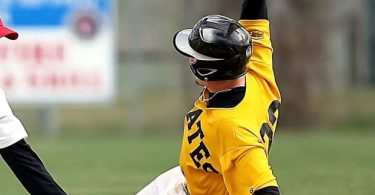The Situation: There’s a runner on second after a lead-off double in the top of the first inning. The right-handed 2-hole batter steps in with a fresh count.
The Play: The pitcher delivers a fastball on the outer corner and the batter swings, seeing his opportunity to move the runner to 3rd base with less than two outs. The ball bounces towards the second baseman, doing the job of moving the runner over. The first baseman, playing back, sees that he can make a play on the ball and goes after it. He gets to the bouncing grounder with relative ease a few steps behind the baseline and half way between first and second base. The second baseman, a few paces behind him, watches with surprise. The first baseman fields the ball on the backhand, pivots and throws to the pitcher covering at first. The pitcher is arriving at the bag at the same time the ball is getting to him, but the throw doesn’t lead him as expected.
The Outcome: The pitcher tries to put on the breaks and reach back for the errant throw, but he can’t slow his momentum. The throw gets behind him and skips into the dugout. The batter ends up at second, trading places with the lead runner, who has come around to score.
What Went Wrong: This is a classic think the game moment. An error that could be avoided by better preparation and communication. The major mistake is made by the first baseman. We are all for being aggressive on balls that you can get to, but there is no reason for a first baseman to take a routine grounder to second and turn it into a more difficult play. Not only does he have to pivot to make the throw, but with the pitcher covering, he has to hit a moving target. A play he can make most of the time, but an unnecessary risk. If the first baseman had been more aware of the second baseman’s positioning to start the AB, he would know that he could easily get to that ball. After a step or two in the direction of the batted ball for an initial read, the first baseman could read the play and get back to cover the bag. It’s an aggressive mistake, but a mistake nonetheless. With better pre-pitch preparation, something that is becoming more important as shifts take fielders away from “natural” fielding locations, this error could be prevented.
Even basic errors can sometimes be prevented by teammates stepping up. The second baseman is at fault here as well. He could have called the ball and made the routine play. In this play, he is surprised by the first baseman’s aggressiveness. Even with the first baseman off the bag, the second baseman has a better angle to deliver the ball to the covering pitcher and has his feet and momentum in a better throwing situation. He should have called for the ball, even if he did it late after his initial surprise. He didn’t and the rest is history.
This play happened to two historically great fielders in a World Series Game 7. Watch the play unfold here. You can never be too prepared for the big situation. Think the game!







